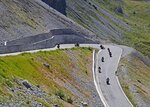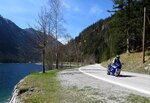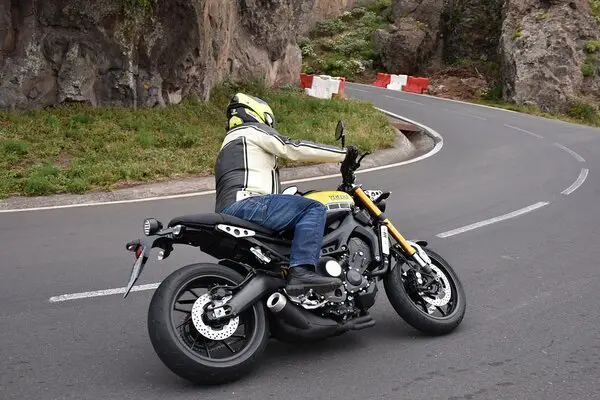Perhaps you are thinking, how do I properly corner and turn the motorcycle in a safe way? It can be quite an intimidating experience, especially with all those problematic turns where you don’t know exactly where to go.
Expert riders are of the view that cornering is a kind of skill that every rider master with time. You just have to understand the mechanisms that are involved during the process. With time, you will be handling those sharp turns like an expert rider.
We will share all the steps that you need to take while cornering and turning your motorcycle safely.
How Do I Properly Corner And Turn The Motorcycle?
Thinking “how do I properly corner and turn the motorcycle” is common with every rider. This is especially the case when you are riding a different kind of motorcycle each time.
Some bikes are heavier and require proper steering, while others are easier to handle on turns because they are lighter. You need to know the basics to handle all kinds of bikes nicely and easily.
Judge your turn from a distance

The first step in resolving the question “how do I properly corner and turn the motorcycle” is to judge the turn. It would be better to judge your turn from a distance. Those sharper turns always have some vanishing points where you don’t see anything on the turn.
You have to keep this point in mind and stay prepared when you are reaching it. Gauging the angle of the turn is essential as well. This way, you will be ready to match it more easily and make the turn with fluidity.
Predicting the end of the turn can be difficult because most of them are blocked from view either due to the vanishing point, vegetation or traffic. Therefore, you have to adjust accordingly. Scope your turn before approaching it, and keep your eyes in front.
Reduce the speed with the turns approaching

It would be best to keep in mind that you have to reduce the speed with the turn nearing. Release the throttle to slow your speed down. You can gently apply the brakes further to reduce the speed if needed.
You have to be at the recommended speed to make the turn safely. Therefore, you can be as slow as you are comfortable right before you enter the turn. If it comes at you quicker, apply both your brakes to slow down.
If you are new to riding and learning cornering art, you should slow down significantly. Make sure to practice well on turns with low traffic. Downshift a couple of gears as well if necessary. It’s all about staying in control, coast through the turn, and speed out.
Approach the turns and slow down. After that, shift down to a lower gear and take a turn. Go about the turn again with one higher gear. And continue to practice.
Check the traffic conditions when you are reaching the turn

You need to keep an eye on the traffic as you reach the turn. Motorcycles are much smaller than other vehicles, so you need to be well aware of the space surrounding you, including your blind spot. Check to see if there is no traffic or there is a gap between you and the traffic.
Any cars accelerating dangerously or erratically should be allowed to pass or have some cushioning distance from them. Don’t rely only on your mirrors, as your elbows will partially block them.
It would help if you also were cautious when doing a bit of checking on your blind spots. Turning your head too far over your shoulder will make you turn your handlebars that much as well. It might throw you off balance while approaching the turn.
Counter-steering for follow-through

You might think it’s not intuitive, but you usually and slightly turn your wheel in the opposite direction, where you want to turn. When you try to steer in the opposite direction, the bike will lean towards the path where you want to turn.
With your bike’s geometry and steering, it will continue to follow through in the direction of leaning. You can continue to apply a slight pressure away from the turn.
After that, you need to straighten out and get back out of turn. You can do this by turning the heel more inwards, which will straighten the bike up.
Ensure to practice counter-steering first in a large open area with traffic when there are no pedestrians. You can get a bit of speed and to turn left, you will need to push your right handlebar away. To straighten it up, you need to pull back the handlebar.
Don’t cling to your handlebar too firmly. New riders hold it too tight out of fear as they try to lean deeper into the turn. But by doing so, you are making the pushing force even more difficult. Your lower body keeps you attached to your bike.
Keep your eyes on the roadway that is coming up

You have to keep your eyes forward and don’t focus too much on the turn. You need to keep finding the farthest point you can see. This way, you will be better prepared for any unforeseen features or conditions on the road and have a rough time reacting.
But make sure you’re not overly focused, so you entirely lose the vision of the objects in your peripheral vision. At the sharp curves where your bike has to lean deeper, other cars might not be able to see your bike. This is where your peripheral vision comes in, and it can save your life.
Increase the throttle at the final section of the turn
You will be able to upright your motorcycle as soon as you emerge from the turn. Keep your weight evenly distributed as soon as you pull out from the corner and release your downward pressure. You are out of the turn, and you can proceed normally on the straight road ahead.
Ensure to avoid throwing your weight on either side because the forces acting on your bike will make it upright again. You might end up throwing your bike off its stability and cause an accident.
Correctly turning your bike
You have to understand that speed is not what you are going to use on your turn. You might think about going through the turn without pressing the brakes, but it will be hazardous for you and others.
Your final goal is not to have a specific speed while turning. The ultimate goal is to be in control at all times. Make sure you don’t have to make any correction in your body’s angle or speed during the turn.
With experience, you will notice you are becoming extremely comfortable on the turns. And you will naturally be able to cut turns at higher speeds. Keep your eyes on the road and your surroundings.
Make corrections when you are going too fast
While turning, if there is an irresistible impulse to push the brakes and slow your throttle, you might be going too fast. When you’re feeling safe on your bike, you are going at the right speed. The speed at which you should take your turn also depends on your stature, the type of your bike, and the road conditions.
FAQ
In what gear should you turn your bike?
Right before entering a corner, you need to have the right speed. You must have the right gear in which you are comfortable controlling your bike and accelerating. You can be in any gear according to your preferences and skills.
Why do motorcyclists lean into corners?
When you turn right, with counter-steering gyroscope and gravity forces for a moment and push your front wheel towards your left, it forces the bike to steer in the opposite direction. Therefore, you need to go for smaller adjustments with steering. You don’t need to keep a constraint pressure on your handlebar.
Do I have to lean on my motorcycle?
Motorbikes tend to accelerate harder and stop faster when they are straight up or down. This is because the tires have the most footprint on the road. In vertical positions, suspension components also work the best. With a leaning bike, you are side-loading it, and that encourages frame flex and binding.
Conclusion
There you have it. Now you know how do I properly corner and turn the motorcycle. It’s not that difficult when you keep control of your bike and keep your eye on the road as well as your surroundings. This way you will be able to approach and get out if the turn is the safest possible way.
Keep your bike as slow as you are comfortable and give way to the fast-moving vehicles around you.

